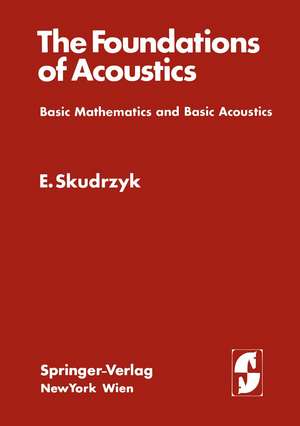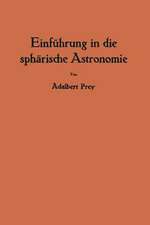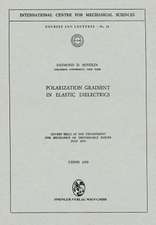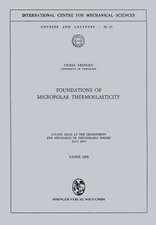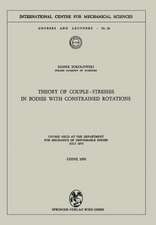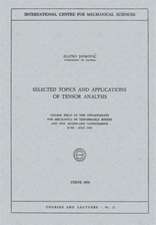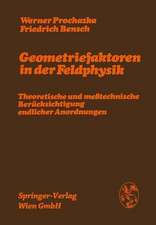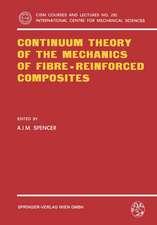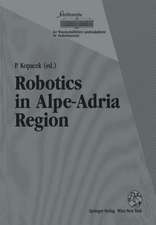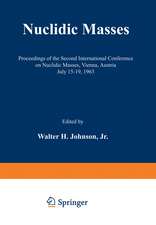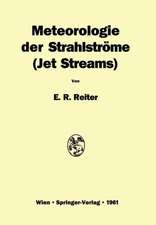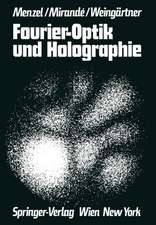The Foundations of Acoustics: Basic Mathematics and Basic Acoustics
Autor Eugen Skudrzyken Limba Engleză Paperback – 7 ian 2012
Preț: 1141.58 lei
Preț vechi: 1392.17 lei
-18% Nou
Puncte Express: 1712
Preț estimativ în valută:
218.45€ • 225.70$ • 181.72£
218.45€ • 225.70$ • 181.72£
Carte tipărită la comandă
Livrare economică 19 martie-02 aprilie
Preluare comenzi: 021 569.72.76
Specificații
ISBN-13: 9783709182574
ISBN-10: 3709182573
Pagini: 820
Ilustrații: XXVIII, 790 p.
Dimensiuni: 170 x 244 x 43 mm
Greutate: 1.39 kg
Ediția:Softcover reprint of the original 1st ed. 1971
Editura: SPRINGER VIENNA
Colecția Springer
Locul publicării:Vienna, Austria
ISBN-10: 3709182573
Pagini: 820
Ilustrații: XXVIII, 790 p.
Dimensiuni: 170 x 244 x 43 mm
Greutate: 1.39 kg
Ediția:Softcover reprint of the original 1st ed. 1971
Editura: SPRINGER VIENNA
Colecția Springer
Locul publicării:Vienna, Austria
Public țintă
ResearchDescriere
Research and scientific progress are based upqn intuition coordinated with a wide theoretical knowledge, experimental skill, and a realistic sense of the limitations of technology. Only a deep insight into physical phenomena will supply the necessary skills to handle the problems that arise in acoustics. The acoustician today needs to be well acquainted with mathematics, dynamics, hydrodynamics, and physics; he also needs a good knowledge of statistics, signal processing, electrical theory, and of many other specialized subjects. Acquiring this background is a laborious task and would require the study of many different books. It is the goal of this volume to present this background in as thorough and readable a manner as possible so that the reader may turn to specialized publications or chapters of other books for further information without having to start at the preliminaries. In trying to accomplish this goal, mathematics serves only as a tool; the better our understanding of a physical phenomenon, the less mathematics is needed and the shorter and more concise are our computa tions. A word about the choice of subjects for this volume will be helpful to the reader. Even scientists of high standing are frequently not acquainted with the fundamentals needed in the field of acoustics. Chapters I to IX are devoted to these fundamentals. After studying Chapter I, which dis cusses the units and their relationships, the reader should have no difficulty converting from one system of units to any other.
Cuprins
Historical Introduction.- I. Equations and Units.- 1.1. Dimensional and Numerical Equations.- 1.2. The kg-m-sec-amp System of Units.- 1.3. The Definition of the Unit of Electric Current, the Ampere [A].- 1.4. Derived Electrical Units.- 1.5. The Practical (Physical) Units for Electrical Quantities.- 1.6. The Fundamental Electrical Laws.- 1.7. Transformation of Units.- II. Complex Notation and Symbolic Methods.- 2.1. Complex Notation and Rotating Vectors.- 2.2. Computations with Complex Vectors.- 2.2.1. Definitions.- 2.2.2. Addition.- 2.2.3. Subtraction.- 2.2.4. Multiplication.- 2.2.5. Division.- 2.2.6. Logarithm of a Complex Number.- 2.2.7. Raising a Complex Number to a Given Power.- 2.2.8. Differentiation and Integration.- 2.3. Conjugate Complex Vectors and Their Applications.- 2.4. Addition of Harmonic Functions of the Same Frequency.- 2.5. Symbolic Method for Solving Linear Differential Equations.- 2.6. Complex Solution and Boundary Conditions.- 2.7. Computation of Power.- 2.8. Basic Theory of Internal Friction.- III. Analytic Functions: Their Integration and the Delta Function.- 3.1. Analytic Functions.- 3.2. Representation of an Analytic Function by a Power Series.- 3.3. Cauchy’s Formula.- 3.4. The Cauchy Integral Formula.- 3.5. Residues.- 3.6. Examples.- 3.6.1. Evaluation of Integrals of the type $$ \int\limits_0^{2\pi } {R\left( {\cos \theta ,\sin\theta } \right)d\theta } $$.- 3.6.2. Summation of a Series by Contour Integration.- 3.7. Evaluation of Integrals of the Form $$ \int\limits_{ - \infty }^\infty {Q\left( x \right)dx} $$.- 3.7.1. Integrals Involving Sines and Cosines.- 3.8. Contour Integrals for Hankel and Bessel Functions.- 3.9. Jordan’s Lemma.- 3.10. Integrals Through Poles, Principal Value of Integrals.- 3.11. Multivalued Functions.- 3.12. Contour Integrals in Vector Notation.- 3.13. Determination of the Real and the Imaginary Parts of an Analytic Function (the Hilbert Transform).- 3.14. Debye’s Saddle-Point Method.- 3.15. Method of Stationary Phase.- 3.16. Example: Stirling’s Formula.- 3.17. Double Integrals.- 3.18. Differentiation and Integration of Integrals with Respect to Parameters.- 3.19. The Delta Function.- 3.20. Transformation of the Variables in Integrals.- 3.21. Singular Points, Integral-, Rational-, and Meromorphic Functions.- 3.22. Singularities of a Second Order Differential Equation.- 3.22.1. The Wronskian Determinant.- 3.22.2. Second Independent Solution of Second Order Differential Equation.- 3.22.3. Ordinary Points and Regular Singular Points.- 3.22.4. Essential Singularity and Branch Point.- 3.22.5. Irregular Singular Point.- 3.22.6. How to Solve a Differential Equation.- IV. Fourier Analysis.- 4.1. The Fourier Series.- 4.2. Examples.- 4.2.1. The Fourier Spectrum of a Periodic Series of Short Pulses.- 4.2.2. The Fourier, Spectrum of a Periodically Repeated Saw-Tooth Curve.- 4.2.3. Fourier Spectrum of a Warble Tone.- 4.3. Fourier Analysis in Terms of Rotating Vectors.- 4.4. Completeness of the Fourier Series and Parseval’s Theorem.- 4.5. Fourier Analysis with the Aid of Filters.- 4.6. Transition to the Fourier Integral.- 4.7. Example: A Point-Mass Compliance System Excited by a Pulse of Very Short Duration.- 4.8. Relation Between Fourier Transform and Fourier Coefficient.- V. Advanced Fourier Analysis.- 5 1 Important Relations in Fourier Analysis.- 5.1.1. Requirements for the Existence of a Fourier Transform.- 5.1.2. Degree of Convergence of a Fourier Series.- 5.1.3. Spectral Amplitude at Low Frequencies: Theorem I.- 5.1.4. Translation of Origin of Time: Theorem II.- 5.1.5. Translation of the Origin in Frequency Space: Theorem III.- 5.1.6. Similarity Theorem: Theorem IV, Compression of Frequency Scale.- 5.1.7. Amplitude Modulation: Theorem V.- 5.1.8. Convolution: Theorem VI.- 5.1.9. Partial-Fraction Development: Theorem VII.- 5.2. Enforced Convergence of Fourier Integrals by Assuming Infinitely Small Damping of the Time Function.- 5.3. Enforcing Convergence by Assuming the High Frequency Components of the Spectrum to be Dissipated.- 5.4. The Shape of an Impulse and Its Spectrum.- 5.5. Examples.- 5.5.1. The Step Function ?0 (t) and Its Spectrum.- 5.5.2. The Rectangular Pulse and the Impulse Function ?i (t).- 5.5.3. Switching on of a Sinusoidal Vibration.- 5.5.4. The Spectrum of a Sinusoidal Vibration of Finite Duration.- 5.5.5. Frequency Modulated Pulse with Sliding Modulation Frequency (“FM Slide”).- VI. The Laplace Transform.- 6.1. One-Sided Time Functions and Enforced Convergence.- 6.2. Computation Rules.- 6.3. Example: The Vibrating Point Mass-Spring.- VII. Integral Transforms and the Fourier Bessel Series.- 7.1. The Fourier Transform.- 7.2. The Laplace Transform.- 7.3. The Infinite Hilbert Transform.- 7.4. The Finite Hilbert Transform.- 7.5. The Mellin Transform.- 7.6. The Infinite Hankel Transform.- 7.7. The Finite Hankel Transform and the Fourier Bessel Series.- VIII. Correlation Analysis.- 8.1. Power Spectrum and Correlation Function.- 8.2. Cross-Spectral Density and Cross-Correlation Function.- 8.3. Running Fourier Transform and Instantaneous Power Spectrum.- 8.4. Running Autocorrelation Function.- 8.5. Derivatives of the Correlation Function.- 8.6. Convolution Integral and Power Spectrum.- IX. Wiener’s Generalized Harmonic Analysis.- X. Transmission Factor, Filters, and Transients (“Küpfmüller’s Theory”).- 10.1. The Transients of Mechanical and Electrical Systems.- 10.2. The Transmission Factor.- 10.3. Relations Between Real Part and Imaginary Part of Transmission Factor.- 10.4. Relation Between Amplitude Response and Phase Response or Time Delay.- 10.5. Frequency Curve and Acoustic Quality.- 10.6. Exact Computation of the Transients by Convolution of Signal with Response for Step or Impulse Function.- 10 7 Exact Computation of the Transient for the Impulse Function.- 10.8. Two Causes for Transients: Phase Distortion and Amplitude Distortion.- 10.9. Phase Distortion and Group Delay.- 10.10 Examples.- 10.10.1. The Series Resonant Circuit.- 10.10.2. The Time Delay of a Wave Traveling in a Rod and Reflected at the Driving Piezoelectric Crystal.- 10.10.3. Time Delay in Low-Pass and High-Pass Filters.- 10.11. Transients Caused by Frequency-Dependent Amplitude Response.- 10.12. Response for Impulse and Step Function.- 10.12.1. The Ideal Low-Pass Filter.- 10.12.2. Low-Pass Filter with Discontinuities of the Transmission Factor.- 10.12.3. Periodic Fluctuations of the Frequency Curve of the Filter in the Pass Range.- 10.12.4. Transients for a Low-Pass Filter with Arbitrary Frequency Transmission.- 10.12.5. The High-Pass.- 10.12.6. Band-Pass.- 10.12.7. Bandpass of Arbitrary Transmission Factor.- 10.13. Transients for Sinusoidal Oscillations as Input Functions.- 10.14. Transients Generated by Phase Distortion.- 10.14.1. Phase Distortion Alone.- 10.14.2. Ideal Low-Pass with Phase Distortion.- 10.14.3. Symmetric Band-Pass with Phase Distortion.- 10.15. Search-Tone Analysis.- XI. Probability Theory, Statistics, and Noise.- 11.1. Basic Concepts of Probability Theory and Statistics.- 11.1.1. Statistical, Random, or Stochastic Variable.- 11.1.2. Set of Functions.- 11.1.3. Ensemble of Functions.- 11.1.4. Stationary Random Function.- 11.1.5. Variations with Time and from Sample to Sample.- 11.2. Ergodic Hypothesis.- 11.3. Statistical Independence.- 11.4. The Probability Distribution for the Sum of Two Independent Random Variables.- 11.5. Probability Density of the Values of a Function of a Stochastic Variable.- 11.6. Mean, Variance, Standard Deviation, and Moments.- 11.7. Characteristic Function.- 11.8. Central Limit Theorem.- 11.9. The Binomial Distribution.- 11.10. The Poisson Distribution.- 11.11. The Rayleigh Distribution.- 11.12. The Normal or Gaussian Distribution.- 11.13. Multidimensional Normal Distribution.- 11.14. Chi-Square Distribution.- 11.15. Standard Deviation, Skewness, and Flatness of a Distribution.- 11.16. Relationship Between Binomial, Poisson, and Normal Distribution.- 11.17. White Noise.- 11.18. Thermal Noise.- 11.19. Measurements with Gaussian Noise.- 11.20. Appendix: Unbiased Estimate of Variance of Small Sets of Samples.- XII. Signals and Signal Processing.- 12.1. Beats and Signals.- 12.2. Resolution in Time and Frequency Domain.- 12.3. Sampling Theorem in Time Domain.- 12.4. Sampling Theorem in Frequency Domain.- 12.5. Derivation of the Sampling Theorems by Convolution Method.- 12.6. Sampling and Scatter of Mean Values for Samples of Limited Dimensions.- 12.7. Detection of a Periodic Signal of Infinite Duration in Noise.- 12.7.1. By Autocorrelation.- 12.7.2. Gain in Detection of Periodic Signal by Cross Correlation.- 12.8. Determination of Periodic Component in Random Wave.- 12.9. Rectifier with an RC Filter.- 12.10. Square-Law Detector.- 12.11. Ideal Correlator.- 12.12. Two-Channel Correlator.- 12.13. Sign Correlator.- 12.14. Two-Channel Sign Correlator.- 12.15. Comparison of the Systems.- 12.16. The Variable Reference Level Correlator.- 12.17. Practical Correlators.- 12.17.1. Analog and Sampling Correlator.- 12.17.2. Dynamic Reference Correlator.- 12.17.3. Delay Line or Deltic Correlator.- 12.17.4. Static Reference Correlators.- 12.18. Signal-to-Noise Ratio and Optimum Processing.- 12.19. Matched-Filter System.- 12.19.1. Constant Frequency Pulses.- 12.19.2. Monotonic Frequency-Modulated Pulses.- XIII. Sound.- 13.1. Definition of Sound.- 13.2. The Sound Variables.- 13.3. The State Equation.- 13.4. Examples.- 13.4.1. Relationship Between Sound Velocity c and Bulk Modulus ?K of a Fluid.- 13.4.2. The Sound Velocity of an Ideal Adiabatic Gas.- 13.5. The Euler Equation.- 13.6. The Continuity Equation.- 13.7. The Wave Equation.- 13.8. The Velocity Potential.- 13.9. The Wave Equation for Forced Vibrations.- 13.10. The Physical Significance of the Velocity Potential.- 13.11. Wave Equation for an Inhomogeneous Medium.- 13.12. The Effect of Viscosity.- XIV. The One-Dimensional Wave Equation and Its Solutions.- 14.1. Plane Sound Waves.- 14.2. Progressive Wave Solution.- 14.3. Standing Wave Solution.- 14.4. The Relation Between the Standing-Wave and the Progressive-Wave Solution.- 14.5. Pressure and Particle Velocity in a Plane Progressive Wave.- 14.6. Radiation Resistance in the Plane Wave.- XV. Reflection and Transmission of Plane Waves at Normal Incidence.- 15.1. Reflection at a Rigid Surface.- 15.2. Reflection at Resilient Surface.- 15.3. Reflection at the Interface Between Two Media and the Coefficient of Absorption.- 15.4. Acoustic Point Impedance.- 15.5. Reflection and Absorption at an Interface Whose Properties Are Represented by an Acoustic Point Impedance.- 15.6. Graphical Procedure to Construct the Reflection and Absorption Factor for Any Acoustical Impedance.- 15.7. Sound Field in Front of an Absorbent Reflector at Normal Incidence.- 15.8. Measurement of Acoustic Impedances for Normal Incidence by the Standing Wave Method.- 15.9. Description of the Sound Field in Front of an Absorbing Surface in Terms of Complex Harmonic Functions.- 15.10. Reflection Factor and Time Delay.- 15.11. Reflection Factor Relative to an Arbitrarily Selected Plane Parallel to the Plane of the Reflector.- XVI. Plane Waves in Three Dimensions.- 16.1. Plane Waves in Three-Dimensional Space.- 16.2. Reflection of a Plane Wave at Oblique Incidence.- 16.2.1. Rigid Reflecting Surface.- 16.2.2. Resilient Reflector.- 16.2.3. Reflecting Medium Described by Its Acoustic Impedance.- 16.2.4. Reflecting Medium Infinitely Extended; Refraction and Snell’s Law.- 16.3. Sound Radiation of an Infinite Plate Excited to a Sinusoidal Vibration Pattern.- 16.3.1. Nodal Line Pattern Independent of Frequency.- 16.3.2. Nodal Line Pattern Not Fixed, but Due to Bending Vibrations of a Plate of Constant Thickness.- XVII. Sound Propagation in Ideal Channels and Tubes.- 17.1. The Solution of the Wave Equation, Sound Velocity, Phase Velocity, and Group Velocity.- 17.2. Propagating Waves and Distortion Fields.- 17.3. Sound Propagation in Channels and Tubes Below Their Radial Resonant Frequency.- 17.3.1. Both Terminations Rigid.- 17.3.2. Tube Terminations Resilient (Open Ends).- 17.3.3. One End of Tube Resiliently Terminated, the Other Rigidly Closed.- 17.3.4. Tube with an Abrupt Change of Cross Section.- 17.4. Change of Cross Section as Acoustic Transformer.- 17.5. Sound Propagation in Infinitely Long Horns.- 17.6. Sound Propagation in Channels and Tubes with Non-Plane Rigid Terminations Below the First Non-Axial Resonance.- 17.7. Examples.- 17.7.1. Tube Terminated by a Conical Horn.- 17.7.2. Tube Terminated by Tube of Different Diameter.- 17.7.3. Rectangular Tube Terminated by an Oblique Wall.- 17.8. The Natural Frequencies of Pipes with Different Terminations.- XVIII. Spherical Waves, Sources, and Multipoles.- 18.1. The Wave Equation for Centrally Symmetric Spherical Propagation and its Solution.- 18.2. Farfield and Nearfield.- 18.3. Sound Pressure and Volume Flow.- 18.4. Spherical Wave Impedance and Radiation of Small Sound Sources.- 18.5. The Sound Power Generated by a Pulsating Sphere.- 18.6. Radiation Resistance and Effective (Acoustic) Mass of a Small Pulsating Source and the Equivalent Sphere.- 18.7. Radiation Resistance Referred to Volume Flow.- 18.8. Standing Spherical. Waves of Zero Order.- 18.9. Acoustic Dipoles and Oscillating Rigid Bodies.- 18.10. The Radiation Resistance of a Small Oscillating Rigid Body.- 18.11. The Effective (Acoustic) Mass for a Small Oscillating Body of Any Shape.- 18.12. Examples.- 18.12.1. The Effective (Acoustic) Mass for an Oscillating Sphere.- 18.12.2. The Sound Radiation of a Piston Membrane that is Not Enclosed in a Baffle.- 18.13. The Motion of a Small Rigid Sphere or a Solid Particle in a Sound Wave.- 18.14. Quadrupole Radiators.- 18.15. Sound Radiation at High Frequencies.- 18.16. Reflection of a Spherical Wave at a Plane Boundary.- 18.17. Interaction Between Sound Sources and Between Sound Sources and Their Images.- 18.17.1. (a) Interaction Between Sound Sources of Zero Order.- 18.17.2. (b) Interaction Between Dipoles.- 18.17.3. Interaction Between Quadrupoles.- 18.18. Radiation from Nonperiodic Sources, Dipoles, and Quadrupoles.- XIX. Solution of the Wave Equation in General Spherical Coordinates.- 19.1. The Wave Equation in General Spherical Coordinates.- 19.2. Solution of the Wave Equation.- 19.3. The Surface Harmonics or Laplace Functions.- 19.4. Radial Part of the Solution.- 19.4.1. The Stokes Functions.- 19.4.2. Bessel Function Solution and the Spherical Bessel Functions.- 19.5. Radiation Impedance of a Sphere Vibrating in a Spherical Harmonic.- XX. Problems of Practical Interest in General Spherical Coordinates.- 20.1. Development of a Power of into Legendre Polynomials.- 20.2. Radiation from a Sphere Vibrating with Axial Symmetry.- 20.3. Point Source on Sphere, Shielding of Radiation by Sphere.- 20.4. The Pressure at the Surface of a Scattering Sphere.- 20.5. Sound Radiation of a Radially Vibrating Spherical Cap Set in a Sphere.- 20.6. Axially Vibrating Cap Set in a Rigid Sphere.- 20.7. Acoustic Radiation from Plane Circular Piston Set in a Rigid Sphere.- 20.7.1. The Minimum Error Method.- 20.7.2. Application to the Plane Piston Set in a Sphere.- 20.8. Representation of a Plane Wave by a Series of Concentric Spherical Waves.- 20.9. Reflection and Refraction of a Plane Wave at a Rigid Sphere.- 20.10. Reflection at Compressible Sphere or at Sphere Covered with Acoustic Absorbent.- 20.11. Spherical Liquid Lens.- 20.12. The Cavity Resonator.- 20.13. Relation Between Multipoles and Wave Functions.- XXI. The Wave Equation in Cylindrical Coordinates and Its Applications.- 21.1. Derivation of the Wave Equation in Cylindrical Coordinates for the Pulsating Cylinder.- 21.2. The Radially Symmetric Wave Equation and the Structure of Its Basic Solutions.- 21.3. The Wave Equation in General Cylindrical Coordinates.- 21.4. The Solution of the Wave Equation—General Cylindrical Coordinates.- 21.5. Sound Propagation in Circular Tubes.- 21.6. Progressive Cylindrical Waves.- 21.7. Rotating Modes.- 21.8. Standing Cylindrical Waves.- 21.9. Infinitely Long Cylinder Excited in a Single Vibrational Mode.- 21.10. Radiation Impedance of a Vibrating Cylinder.- 21.11. The Power Radiated Per Unit Area of the Cylinder.- 21.12. The Pulsating Cylinder.- 21.13. Sound Radiation of an Infinitely Long String.- 21.14. The Cylindrical Quadrupole.- 21.15. Reaction Between Two Parallel Cylindrical Sources of Zero Order.- 21.16. Scattering of Normally Incident Plane Wave at a Rigid Cylinder.- 21.17. Cylinder with End Caps.- XXII. The Wave Equation in Spheroidal Coordinates and Its Solutions.- 22.1. Prolate Spheroidal Coordinates.- 22.2. The Wave Equation in Spheroidal Coordinates.- 22.3. The Angle Functions.- 22.4. The Radial Functions.- 22.5. Modal Velocities and the Weighted Modal Velocities, Sound Pressure and Particle Velocity in Spheroidal Coordinates.- 22.6. Sound Pressure and Particle Velocity in Spheroidal Coordinates.- 22.7. Integrated or Total Modal Radiation Impedance.- 22.8. Approximations for Thin and Long Spheroids.- 22.9. Examples.- 22.9.1. Sound Pressure at Arbitrary Distance ? on Polar Axis (? = 1) Due to a Thin Spheroid Vibrating in the (01) Mode.- 22.9.2. Numerical Example, Sound Pressure Generated by a Thin Spheroid in (00) and (01) Mode on Polar Axis.- 22.10. The Integrated Modal Impedance for a Thin Spheroid.- 22.11. Radiation by Rigid Body Axial Vibration.- 22.12. Radiation by “Accordion” Vibration Mode.- 22.13. Oblate Spheroidal Coordinates.- 22.14. Example: Pressure Generated by a Circular Piston That is Not in a Baffle.- 22.15. Tables on Spheroidal Wave Functions.- 22.16. Appendix: Curvilinear Coordinates.- 22.16.1. Coordinate Transformations and the Metric Tensor.- 22.16.2. Fundamental, Differential Operators in Curvilinear Coordinates.- XXIII. The Helmholtz Huygens Integral.- 23.1. Green’s Integral Formula and Gauss’ Theorem.- 23.2. Helmholtz Huygens Radiation Integral.- 23.2.1. The Integration Surface Surrounds the Field Point and Separates It from Sources.- 23.2.2. Field Point and Sources Outside Surface of Integration.- 23.2.3. Surface of Integration Encloses Field Point and Sources. The Sommerfeld Infinity Condition.- 23.2.4. The Helmholtz Huygens Integral for any Surface of Integration.- 23.3. Field Point and One Source Inside Surface of Integration, Other Sources Outside.- 23.4. The Helmholtz Huygens Integral with Internal Sources and Forces.- 23.5. The Simplified Diffraction Formulae and the Green’s Function.- 23.5.1. Transition from the Helmholtz Huygens Radiation Integral to Huygens Theorem for Plane Radiators and Screens.- 23.5.2. Helmholtz Huygens Integral for the Pressure.- 23.6. Physical Meaning of the Helmholtz Huygens Integral.- 23.7. The Many-Valuedness of the Source and Dipole Distributions in the Helmholtz Huygens Integral.- 23.8. The Helmholtz Huygens Integral as a Solution of a Discontinuity Problem.- 23.9. Examples.- 23.9.1. The Sound Field Scattered at a Small Incompressible Particle or Generated by a Small Oscillating Particle.- 23.9.2. Scattering by Inhomogeneities of the Medium.- 23.10. Other Forms of the Radiation or Diffraction Integral.- 23.10.1. Axially Symmetric Field.- 23.10.2. King’s Diffraction and Radiation Integral.- 23.11. The Helmholtz Huygens Integral for Unsteady Phenomena.- 23.12. Poisson’s Wave Formula.- XXIV. Huygens Principle and the Rubinowicz—Kirchhoff Theory of Diffraction.- 24.1. The Huygens—Rayleigh Integral.- 24.2. Huygens Zone Construction.- 24.3. Examples.- 24.3.1. The Plane Sound Wave.- 24.3.2. The Sound Field Along the Central Axis of a Piston Membrane (or Circular Aperture) as a Function of the Distance. Ray Region and Region of Spherical Propagation.- 24.4. Kirchhoff Theory of Diffraction.- 24.5. Babinet’s Principle.- 24.6. The Diffraction Integral of Rubinowicz.- 24.7. The Edge Wave.- 24.7.1. The Edge Wave at High Frequencies and at a Great Distance from the Screen or Vibrator and Far Away from the Shadow Boundary.- 24.7.2. Near the Shadow Boundary.- 24.8. Application of the Theory.- 24.8.1. Piston Membrane.- 24.8.2. Series Developments and Approximate Solutions for Diffraction at Circular Disc or Radiation by Piston Membrane for the Vicinity of the Disc or Piston.- 24.8.3. Plane Wave Diffracted at Semi Infinite Plane.- 24.9. Spherical Wave Diffracted at Edge of a Semi Infinite Plane.- 24.10. Analytic Continuation of the Kirchhoff Integral.- 24.11. Non Plane Screens.- 24.12. Phase Anomaly Near Focus.- 24.13. Comparison of the Kirchhoff Assumptions and the Results of the Kirchhoff Theory with the Results of Accurate Computations.- 24.14. Appendix: Series and Asymptotic Development of the Fresnel Integral.- XXV. The Sommerfeld Theory of Diffraction.- 25.1. The Properties of the Sommerfeld Function $$ \omega \left( {r,\varphi ,z,r{}_0,{\varphi _0},{z_0};{2_\chi }} \right) $$ for the Straight Edge and Wedge for a Plane Incident Wave.- 25.2. The Derivation of the Sommerfeld Function w.- 25.3. The Sound Field Inside a Wedge of Angular Opening 2?/n.- 25.4. The General Multivalued Solution.- 25.5. The Straight Edge (p = 2).- 25.6. Approximations to the Sommerfeld Functions.- 25.7. Approximate Evaluation of the Sommerfeld Solution for the Straight Edge.- 25.8. Spherical Incident Wave.- 25.9. Black Screens.- 25.10. The Wedge.- 25.11. The Concept of Riemann Spaces.- 25.12. The Generalized Babinet Principle.- 25.13. Approximate Treatment of Diffraction by Screens and by Three-Dimensional Objects; J. B. Keller’s Method.- 25.13.1. Keller Approximation for Plane Screens.- 25.13.2. Examples.- 25.13.3. Keller Approximation for Three-Dimensional Diffractors.- 25.13.4. The Shadowing Effect of a Hemisphere and of Three-Dimensional Screens.- XXVI. Sound Radiation of Arrays and Membranes.- 26.1. Basic Definitions: Hydrophone Sensitivity, Directivity Function, Directivity Factor, and Directivity Index.- 26.2. The Fraunhofer Integral and the Directivity Function.- 26.3. Examples for Arrays with Point Sources of Constant Strength.- 26.3.1. Two Point Sources of Equal Volume Flow at x = 0 and x = d, Respectively.- 26.3.2. Point Sources Equally Spaced Along a Line.- 26.4. Major and Minor Lobes, Repetition of Directivity Pattern of Linear Array.- 26.5. The Densely Packed Linear Array.- 26.6. Circular Ring Densely Packed with Transducers.- 26.7. Transducers at Constant Intervals Along a Circular Ring.- 26.8. The Circular Piston Membrane in a Baffle and the Circular Aperture.- 26.9. The Rectangular Piston Membrane in a Baffle.- 26.10. Comparison of the Directivity Functions of Various Arrays.- 26.11. Variable Velocity Distributions.- 26.12. Rectangular Membrane.- 26.12.1. Rectangular Membrane Supported at Two Edges.- 26.12.2. Rectangular Membrane With Free Edges.- 26.12.3. Comparison of the Directivity Patterns of Rectangular Membranes in Their Fundamental Mode.- 26.12.4. Circular Membrane, Rigidly Supported at Its Circumference.- 26.12.5. Circular Membrane; Azimuthal and Radial Nodal Lines.- 26.12.6. Directivity Function of Compound Arrays.- 26.13. Shaded Arrays.- 26.14. Binomial Group.- 26.15. Sound Sources at the Corner Points of a Two-Dimensional Grating and the Rectangular Piston Membrane.- 26.16. The Sharpness of the Directivity Pattern.- 26.17. Chebyshev Shaded Array.- 26.18. Chebyshev Polynomials.- 26.18.1. Example.- 26.18.2. Spacing of Transducer Elements.- 26.19. Sum and Difference Patterns.- 26.20. Synthesis of the Difference Pattern.- 26.20.1. Example: Difference Pattern of an Element Array.- 26.21. Directivity Function and Radiation Resistance.- 26.22. Examples.- 26.22.1. Two Sources a Distance d Apart.- 26.22.2. The Rectangular Piston Membrane.- 26.22.3. Membrane or Thin Plate, Rigidly Supported at Its Circumference.- 26.23. The Sound Field in the Proximity of the Radiator: The Fresnel Approximation.- 26.24. Examples.- 26.24.1. Diffraction at a Straight Edge.- 26.24.2. Circular Piston Membrane in an Infinite Baffle.- 26.24.3. The Far Sound Field Generated by a Piston Membrane.- 26.24.4. Application to the Loudspeaker.- 26.25. The Loudspeaker in a Finite Baffle or Without a Baffle.- 26.25.1. Fraunhofer Approximation.- 26.25.2. Fresnel Approximation.- 26.25.3. The Loudspeaker in a Room and Multi-Unit Speakers in Small Baffle and Box.- 26.26. H. Stenzel’s Exact Computation for the Sound Field Generated by a Piston Membrane.- XXVII. The Green’s Functions of the Helmholtz Equation and Their Applications.- 27.1. Definitions.- 27.2. Reciprocity Theorem.- 27.3. The Nature of the Singularity of the Green’s Function.- 27.4. Solution for Finite Space in Terms of the Infinite Space Green’s Function.- 27.5. The Impulse Function and the Time Dependent Solution of the Wave Equation.- 27.6. Expansion of the Green’s Function in Natural Functions.- 27 7 Infinite Space Green’s Function and Complex Natural Functions.- 27.8. Continuous Eigenvalue Spectrum.- 27.9. Examples in Two Dimensions.- 27.9.1. Plane Waves.- 27.9.2. The Axially Symmetric Green’s Function for the Infinite Two-Dimensional Space.- 27.9.3. Cylindrical Waves.- 27.9.4. The Infinite Space Green’s Function in Polar Coordinates in Two Dimensions.- 27.10. Examples in Three Dimensions.- 27.11. The Green’s Function in Spherical Harmonics.- 27.11.1. The Green’s Function in Cylindrical Coordinates.- 27.12. The Green’s Function for Bounded Spaces.- 27.12.1. Perfectly Rigid or Perfectly Resilient Boundary.- 27.12.2. Reflection of a Spherical Wave at an Acoustical Impedance.- XXVIII. Self and Mutual Radiation Impedance.- 28.1. Rayleigh Computation of the Acoustic Impedance of the Piston Membrane in an Infinite Baffle.- 28.2. Computation of the Acoustic Impedance of a Piston Membrane with the Aid of the Green’s Function in Cylindrical Coordinates.- 28.3. The Acoustic Impedance of a Membrane Whose Velocity Varies Over Its Surface.- 28.4. Self and Mutual Radiation Impedance.- 28.5. Example: Mutual Radiation Impedance of Two Rigid Circular Disks.- 28.6. Appendix: Pritchard’s Integrals, Evaluation of an Important Radiation Integral.- Tables.- I. Elementary Functions.- II. Trigonometric Functions.- III. Hyperbolic Functions.- IV. Harmonic and Hyperbolic Functions of Complex Argument.- V. The Inverse Harmonic and Hyperbolic Functions.- VI. Legendre Polynomials and Surface Harmonics.- VII. The Solutions of the Wave Equation.- VIII. Properties of the Bessel Functions.- IX. Spheroidal Functions.- X. The Gamma Function.- XI. The Lommel Functions of Two Variables.- References.- 1. Early History of Acoustics.- 1. Equations and Units.- 2. Complex Notation and Symbolic Methods.- 3. Analytic Functions; Their Integration and the Delta Function.- Chapters 4, 5. Fourier Analysis.- Chapters 6, 7. The Laplace Transform and Transform Theory.- 8. Correlation and Correlation Analysis.- 9. Wiener’s Generalized Harmonic Analysis.- 10. Transmission Factors, Filters, and Transients.- 11. Probability, Theory, Statistics, and Noise.- 12. Signals and Signal Processing.- Chapters 13 to 17. Sound and Simple Sound Fields; Transmission and Reflection; Channels.- 16. Channels and Ducts. (See also Literature Chapters 20, 21.).- 17. Acoustic Impedances and Their Measurement.- 17. Horns.- 17. (Supplementary Literature.) Plates..- Chapters 18, 28. Radiation Impedance.- 18. Simple Spherical Sound Propagation, Sources, Dipoles and Quadrupoles.- 19. The Wave Equation in Spherical Coordinates and Its Solutions, Applications of the Theory.- Chapters 20, 21. The Wave Equation in Cylindrical Coordinates and Its Applications (See also Literature Chapter 17.).- 22. The Wave Equation in Spheroidal Coordinates and Its Solutions.- 23. The Helmholtz-Huygens Integral (See also Literature Chapters 24, 25.).- Chapters 24, 25. Diffraction.- 26. Sound Radiation of Arrays and Membranes. (See also Literature Chapters 24, 25.).- 27. The Green’s Function and Its Application. (See also Literature Chapters 17, 20, 21, 22.).- 28. Radiation Impedance. (See Literature Chapter 18.).- List of Symbols.
Recenzii
“This book provides a comprehensive treatment of a number of topics in acoustics and the mathematics of acoustics. It is well organized and clearly written. It clearly leans heavily to the mathematics … . In summary, I would say that this is an excellent foundation for the mathematics of acoustics and a great reference for the mathematics applicable to particular problems in acoustics.” (James K. Thompson, Noise News International, Vol. 24 (4), December, 2016)
